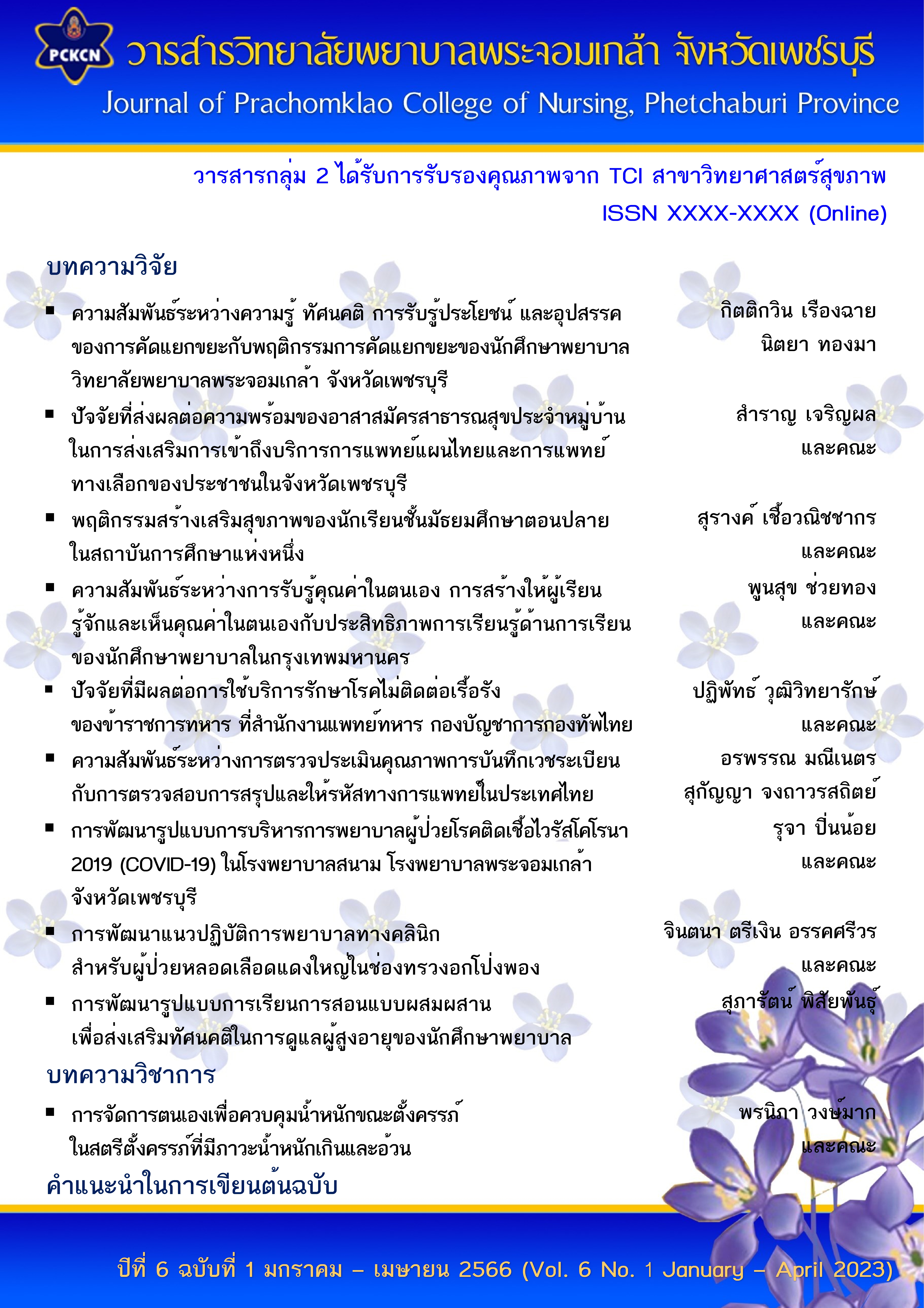พฤติกรรมสร้างเสริมสุขภาพของนักเรียนชั้นมัธยมศึกษาตอนปลาย ในสถาบันการศึกษาแห่งหนึ่ง
Main Article Content
บทคัดย่อ
การวิจัยเชิงสำรวจภาคตัดขวางนี้ มีวัตถุประสงค์เพื่อศึกษาพฤติกรรมสร้างเสริมสุขภาพ และความสัมพันธ์ระหว่างปัจจัยด้านชีวสังคม และปัจจัยด้านจิตวิทยา กับพฤติกรรมสร้างเสริมสุขภาพของนักเรียนชั้นมัธยมศึกษาตอนปลาย สถาบันการศึกษาแห่งหนึ่งในกรุงเทพมหานคร จำนวน 150 คน โดยวิธีการสุ่มตัวอย่างอย่างง่าย เก็บรวบรวมข้อมูลโดยใช้แบบประเมินความรู้สึกมีคุณค่าในตนเอง ความสุข และพฤติกรรมสร้างเสริมสุขภาพ มีค่าความเชื่อมั่นสัมประสิทธิ์แอลฟาของครอนบาค เท่ากับ .89, .83, และ .77 ตามลำดับ วิเคราะห์ข้อมูลโดยใช้สถิติเชิงพรรณนา และทดสอบความสัมพันธ์โดยใช้สถิติการทดสอบไคสแควร์ และสัมประสิทธิ์สหสัมพันธ์แบบเพียร์สัน
ผลการวิจัย พบว่า กลุ่มตัวอย่างมีระดับความรู้สึกมีคุณค่าในตนเอง (M = 65.62, SD = 9.48) ความสุข (M = 116.52, SD = 5.81) และพฤติกรรมสร้างเสริมสุขภาพอยู่ในระดับปานกลาง (M = 76.88, SD = 13.79) ปัจจัยด้านชีวสังคม พบว่า ระดับชั้นปีที่ศึกษามีความสัมพันธ์กับพฤติกรรมสร้างเสริมสุขภาพ อย่างมีนัยสำคัญทางสถิติที่ระดับ .05 (x2 = 11.25) ในขณะที่เพศ อายุ ดัชนีมวลกาย ค่าใช้จ่ายที่ได้รับต่อสัปดาห์ และความเพียงพอของค่าใช้จ่ายต่อสัปดาห์ ไม่มีความสัมพันธ์กับพฤติกรรมสร้างเสริมสุขภาพ ปัจจัยด้านจิตวิทยา พบว่า ความรู้สึกมีคุณค่าในตนเอง และความสุขมีความสัมพันธ์ทางบวกกับพฤติกรรมสร้างเสริมสุขภาพในระดับปานกลาง อย่างมีนัยสำคัญทางสถิติที่ระดับ .01 (r = .33 และ .41 ตามลำดับ)
ผลการวิจัยชี้ให้เห็นว่า ควรนำปัจจัยด้านชีวสังคม และปัจจัยด้านจิตวิทยามาพิจารณาในการทำวิจัยเพื่อการพัฒนาพฤติกรรมสร้างเสริมสุขภาพในนักเรียนชั้นมัธยมศึกษาตอนปลาย
Downloads
Article Details

อนุญาตภายใต้เงื่อนไข Creative Commons Attribution-NonCommercial-NoDerivatives 4.0 International License.
เนื้อหาและข้อมูลที่เผยแพร่ในวารสารวิทยาลัยพยาบาลพระจอมเกล้า จังหวัดเพชรบุรี ถือเป็นข้อคิดเห็นและความรับผิดชอบของผู้นิพนธ์บทความโดยตรง บทความ เนื้อหา ข้อมูล รูปภาพ ฯลฯ ที่ได้รับการเผยแพร่ในวารสารนี้ ถือเป็นลิขสิทธิ์ของวารสารฯ หากบุคคลหรือหน่วยงานใดต้องการนำทั้งหมดหรือส่วนหนึ่งส่วนใดไปเผยแพร่หรือเพื่อกระทำการใด ๆ จะต้องอ้างอิงวิทยาลัยพยาบาลพระจอมเกล้า จังหวัดเพชรบุรี ทุกครั้ง
เอกสารอ้างอิง
Abd Allah, E. S., Ali Elzeiny, H. H., & Ali, R. A. (2015). Health protecting and health promoting behaviors among preparatory school students in Zagazig city. American Journal of Nursing Science, 4(5), 247-54.
Benevene, P., Ittan, M. M., & Cortini, M. (2018). Self-esteem and happiness as predictors of school teachers’ health: The mediating role of job satisfaction. Frontiers in Psychology, 9, Article 933. https://doi.org/10.3389/fpsyg.2018.00933
Bloom, B. S., & Krathwohl, D. R. (2020). Taxonomy of educational objectives: The classification of educational goals. Book 1, Cognitive domain. Longman.
Bureau of Health Promotion, Department of Health, Ministry of Public Health. (2022). Thailand global school-based student health survey, 2021: GSHS. Minni group. (in Thai)
Cast, A. D., & Burke, P. J. (2002). A theory of self-esteem. Social Forces, 80(3), 1041-1068.
Cherwanitchakorn, S, Shuaytong, P., & Karuhadej, P. (2019). Health promoting behavior among nursing students in Dusit district. The Institute of Research and Development, Suan Sunandha Rajabhat University. (in Thai)
Cohen, J. (1988). Statistical power analysis for the behavioral sciences (2nd ed.). Lawrence Erlbaum.
Division of Non-communicable Diseases, Ministry of Public Health. (2023). Number and mortality rate of 5 NCDs 2017-2021 (diabetes mellitus, hypertension, myocardial infarction, stroke, and chronic obstructive pulmonary disease) per 100,000 population classified to provinces, health areas, and overall country (including Bangkok). http://www.thaincd.com/2016/mission/documents-detail.php?id=14480&tid=32&gid=1-020 (in Thai)
Leartsakornsiri, M., & Khampunyo, C. (2017). Factors associated with health promoting behaviors of nursing students at Saint Louis College during practice in the health care service. Naresuan University Journal: Science and Technology, 25(3), 67-76. (in Thai)
Luangthongkum, N., & Phoyen, K. (2017). Mental health of adolescent students in schools located in Mueang Nakhon Pathom district, Mueang Nakhon Pathom Province. Suan Dusit Graduate School Academic Journal, 13(2), 91-110. (in Thai)
Park, J., Kim, Y. H., Park, S. J., Suh, S., & Lee, H. J. (2016). The relationship between self-esteem and overall health behaviors in Korean adolescents. Health Psychology and Behavioral Medicine, 4(1), 175-185.
Pasunon, P. (2014). Sample size determination from Krejcie and Morgan (1970): Approach in quantitative research. The Journal of Faculty of Applied Arts, 7(2), 112-120. (in Thai)
Patton, G. C., Sawyer, S. M., Santelli, J. S., Ross, D. A., Afifi, R., Allen, N. B., Arora, M., Azzopardi, P., Baldwin, W., Bonell, C., Kakuma, R., Kennedy, E., Mahon, J., McGovern, T., Mokdad, A. H., Patel, V., Petroni, S., Reavley, N., Taiwo, K., Waldfogel, J., ... Viner, R. M. (2016). Our future: A Lancet commission on adolescent health and well being. The Lancet, 387(10036), 2423-2478.
Pender, N. J., Murdaugh, C. L., & Parsons, M. A. (2011). Health promotion in nursing practice (6th ed.). Pearson.
Samutachak, P., & Kanchanachitra, M. (2014). What drives consumerism in Thai youth. Thammasart Journal, 33(1), 46-69. (in Thai)
Santrock, J. W. (2014). Essentials of life-span development (3rd ed.). Mc Graw-Hill.
Shaheen, A. M., Nassar, O. S., Amre, H. M., & Hamdan-Mansour, A. M. (2015). Factors affecting health-promoting behaviors of university students in Jordan. Health, 7(1), 1-7. http://dx.doi.org/10.4236/health.2015.71001
Smith, M. K. (2005). Happiness and education-Theory, practice and possibility. https://infed.org/mobi/happiness-and-education-theory-practice-and-possibility/
Solod, W. (2022). Sedentary behaviors increase the risk factor of developing non-communicable diseases (NCDs): Prevention guidelines. Health Science Journal of Nakhon Ratchasima College, 1(2), 42-53. (in Thai)
Sripituk, T., Chutipattana, N., & Thongsamsi, A. (2019). Factors related to health literacy associated with consuming behavior and exercise in preventing obesity syndrome of adolescent students in Yala province. In Hatyai University, The 10th Hatyai National and International Conference (pp. 1529-1545). Hatyai University. (in Thai)
Thongsuk, S., Putawatana, P., & Orathai, P. (2012). Health promoting behaviors of Ramathibodi nursing students. Ramathibodi Nursing Journal, 8(2), 177-189. (in Thai)
Wankrathok, S., & Watcharaach, J. (2018). Factors related to health promotion behavior in junior high school students at educational service area office 18 Chonburi Province. Journal of the Police Nurses, 10(1), 132-141. (in Thai)
Womble, D. M. & Kincheloe, C. A. (2020). Introductory mental health nursing (4th ed.). Wolters Kluwer.
World Health Organization. (2022, 16 Septrmber). Non-communicable diseases. https://www.who.int/news-room/fact-sheets/detail/noncommunicable-diseases


